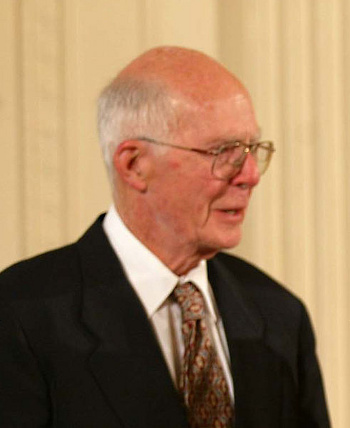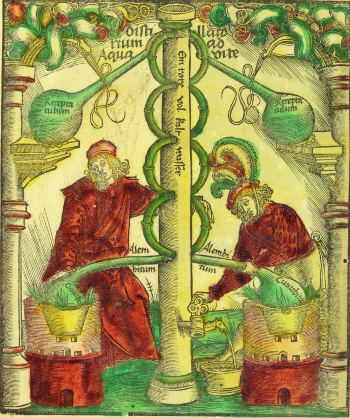2015 Nobel Prize in Physics
October 12, 2015
Our
ancestors blamed quite a few
natural phenomena on invisible agents. The
ancient Greeks had
gods to explain everything from
lightning (
Zeus, Ζευς) to
time (
Chronos, Χρονος). As was proved over time in the
germ theory of disease, some invisible agents were invisible solely because we didn't have the
technology to see them.
While
atoms qualified for a time as invisible agents, their
existence was confirmed, along with the existence of their components,
electrons (
J. J. Thomson, 1897),
protons (
Ernest Rutherford, 1917-1919), and
neutrons (
James Chadwick, 1932). All these discoveries convinced
physicists that every
particle they needed to fill gaps in their
theories would be discovered.
Conservation laws have a special place in physics. Whenever something seems to violate one or another of these laws, physicists are quick to look for some reason why they should appear to be violated, but are not.
Beta decay was a
radioactive decay process that seemed to violate conservation of energy, conservation of momentum, and conservation of angular momentum. Physicist, Wolfgang Pauli (1900-1958) decided in 1930 that an unseen neutral particle must be involved.
Pauli named this particle, the neutron, but this was the name assigned by Chadwick to the very real neutron that he had discovered. Shortly thereafter,
Enrico Fermi renamed Pauli's neutral particle the
neutrino, but for many years there was no direct evidence for the existence of the neutrino. This is not surprising, since a small,
neutral particle of supposedly zero
mass would be quite difficult to detect.
Finally, in a
1956 experiment,
Clyde Cowan, Frederick Reines, and collaborators detected the neutrino. Even then, it was hard to convince everyone of the neutrino's existence. Nearly forty years after his discovery, Frederick Reines received the 1995
Nobel Prize in Physics. Cowan would have shared the prize, but he had died in 1974. I wrote about the gap between major discoveries and the award of a Nobel Prize in a
previous article (A Younger Man's Game?, May 2, 2014)
Originally, the neutrino was thought to have zero mass, and massless neutrinos were never thought to be a problem until the
Homestake experiment of Raymond Davis, Jr.. In that experiment, Davis detected just a third of the neutrinos predicted in 1939 by
Hans Bethe to be emitted by the Sun.[1] This experiment gave birth to the "Solar neutrino problem."

Raymond Davis, Jr. (1914-2006)
Davis was lucky to have lived to a reasonable old age, since his neutrino experiment needed extensive corroboration before the award of his Nobel Prize in Physics in 2002.
Clyde Cowan was not as lucky.
(2001 National Science Foundation photograph, via Wikimedia Commons.)
Davis' experiment was designed to detect just one type of neutrino, the electron neutrino, so it was thought that the electron neutrinos had transformed into a mixture of electron neutrinos, muon neutrinos, and tau neutrinos on their travel from the Sun to Earth. Such a neutrino "flavor" oscillation is only possible if neutrinos have mass; and, additionally, if they have different masses.
As a consequence of certain cosmological constraints, the sum of neutrino masses should be less than about 0.3 eV.[2] A recent measurement sets this sum at 0.320 ± 0.081 eV.[3] For comparison, the electron mass is 0.510998928 MeV, and the proton mass is 938.272046 MeV.
As I've written before, theory is important, but experiment is the final arbiter of
truth. Two experiments confirming neutrino oscillation were the
Super-Kamiokande (Super-K) experiment and the
Sudbury Neutrino Observatory (SNO) experiment. In recognition of these experiments,
Takaaki Kajita of the
University of Tokyo (Japan) and
Arthur McDonald of
Queen's University (Kingston, Canada) have been awarded the 2015 Nobel Prize in Physics.[4-5]. Their neutrino oscillation results were
published from 1998-2002.[6-8]
Both experiments are based on the interaction of neutrinos with the electrons or
nuclei of
water. Such an interaction can produce a
charged particle moving faster than the
speed of light in water, although not faster than the speed of light in a
vacuum, which is
nature's ultimate speed limit. The motion of such particles creates an
optical version of a
sonic boom, a
cone of
light known as
Cherenkov radiation. The cone of light is detected by
photomultiplier tubes at the wall of a
containment vessel. Both experiments are located deep underground to shield them from
background radiation.
The Super-K is a
cylindrical stainless steel tank filled with 50,000
tons of ultra-pure water initially surrounded by 11,146 photomultiplier tubes monitoring the inside of the container, and 1,885 photomultiplier tubes monitoring the outside. The SNO is based on the same idea, but it's a six
meter radius sphere filled with 1,000 tons of
heavy water and an outer cavity filled with normal water. The SNO heavy water is monitored by 9,600 photomultiplier tubes

Alchemical distillation, from Hieronymus Brunschwig, "Liber de arte Distillandi de Compositis," (Strassburg, 1512)
Heavy water, HDO, occurs as one part in 32,000 in natural water, H2O. Since heavy water has a boiling point of 101.4 °C, it is easily separated from water through distillation.
(Chemical Heritage Foundation image, via Via Wikimedia Commons.)
We wouldn't be talking Nobel Prize unless these experiments proved what was intended; namely, that neutrinos change
flavor and must have mass. The Super-K experiment measured the
ratio of muon neutrinos created in
air showers arriving directly overhead to the number from below. The muon neutrinos arriving from below traversed a longer path, through the Earth, and there was a deficit of these neutrinos, thus confirming a flavor change through the longer path.[4] This result was the first experimental confirmation that neutrinos had mass.
A few years later, the SNO experiment was able to measure the number of electron neutrinos and compare it to the total number of neutrinos, finding a smaller number of electron neutrinos than expected, but the number of total neutrinos as predicted by theory, thus indicating a flavor change of electron neutrinos.[4] Massive neutrinos are somewhat of a problem for theorists, since the
Standard Model has massless neutrinos. Says
Samuel Aronson,
President of the
American Physical Society, "The discovery has major bearing on the structure of the
universe as well as the physics of the nucleus."[4] Massive neutrinos might also help to explain why our universe contains mostly
matter and very little
antimatter.[4]
Along with the present honor, Kajita received the
2002 W.K.H. Panofsky Prize in Experimental Particle Physics. McDonald is the recipient of the
2003 Tom W. Bonner Prize in Nuclear Physics.
References:
- H. A. Bethe, "Energy Production in Stars," Physical Review, vol. 55, no. 5 (March, 1939), p. 434-456.
- Ariel Goobar, Steen Hannestad, Edvard Mortsell and Huitzu Tu, "The neutrino mass bound from WMAP-3, the baryon acoustic peak, the SNLS supernovae and the Lyman-alpha forest," arXiv Preprint Server, May 29, 2006. Also available as Ariel Goobar, Steen Hannestad, Edvard Mörtsell and Huitzu Tu, "The neutrino mass bound from WMAP-3, the baryon acoustic peak, the SNLS supernovae and the Lyman-alpha forest," Journal of Cosmology and Astroparticle Physics, vol. 2006, no. 6 (June 2006), pp. 19ff.
- Richard A. Battye and Adam Moss, "Evidence for Massive Neutrinos from Cosmic Microwave Background and Lensing Observations." Physical Review Letters, vol. 112, no. 5 (February 7, 2014), Document No. 051303 [5 pages].
- Emily Conover, "Neutrino Oscillations Nab Nobel Prize - Takaaki Kajita and Arthur McDonald win for discovery of the particles' shape-shifting nature," American Physical Society Press Release, October 6, 2015.
- Simon Johnson and Ben Hirschler, "Nobel Prize for solving puzzle of elusive neutrino particles," Reuters, October 6, 2015.
- Y. Fukuda et al. (Super-Kamiokande Collaboration), "Evidence for Oscillation of Atmospheric Neutrinos, Phys. Rev. Lett., vol. 81, no. 8(August 24, 1998), pp. 1562ff.
- Q. R. Ahmad et al., "Measurement of the Rate of ν[e] + d → p + p + e- Interactions Produced by 8B Solar Neutrinos at the Sudbury Neutrino Observatory," Phys. Rev. Lett., vol. 87, no. 7, (August 13, 2001), Document No. 071301.
- Q. R. Ahmad et al., "Direct Evidence for Neutrino Flavor Transformation from Neutral-Current Interactions in the Sudbury Neutrino Observatory," Phys. Rev. Lett., vol. 89, no. 1, (July 1, 2002), Document No. 011301.
Permanent Link to this article
Linked Keywords: Ancestor; natural phenomenon; ancient Greeks; deity; god; lightning; Zeus; time; Chronos; germ theory of disease; technology; atom; existence; electron; J. J. Thomson; proton; Ernest Rutherford; neutron; James Chadwick; physicist; elementary particle; theory; conservation law; physics; beta decay; radioactive decay; conservation of energy; conservation of momentum; conservation of angular momentum; Wolfgang Pauli (1900-1958); Enrico Fermi; neutrino; electric charge; neutral; mass; Cowan-Reines neutrino experiment; Clyde Cowan; Frederick Reines; collaboration; collaborator; Nobel Prize in Physics; Nobel Prize; Homestake experiment; experiment; Hans Bethe; Sun; solar neutrino problem; Raymond Davis, Jr. (1914-2006); reproducibility; corroboration; Wikimedia Commons; electron neutrino; muon neutrino; tau neutrino; Earth; neutrino flavor oscillation; cosmology; cosmological; electronvolt; eV; electron mass; proton mass; truth; Super-Kamiokande; Sudbury Neutrino Observatory; Takaaki Kajita; University of Tokyo (Japan); Arthur McDonald; Queen's University (Kingston, Canada); scientific literature; publish; atomic nucleus; nuclei; water; electric charge; speed of light; vacuum; nature; optics; optical; sonic boom; cone; light; Cherenkov radiation; photomultiplier tube; container; containment vessel; background radiation; cylinder; cylindrical; stainless steel; ton; meter; radius; sphere; heavy water; alchemy; alchemical; fractional distillation; Hieronymus Brunschwig; boiling point; Chemical Heritage Foundation; flavor; ratio; Standard Model; Samuel Aronson; President; American Physical Society; universe; matter; antimatte; 2002 W.K.H. Panofsky Prize in Experimental Particle Physics; 2003 Tom W. Bonner Prize in Nuclear Physics.